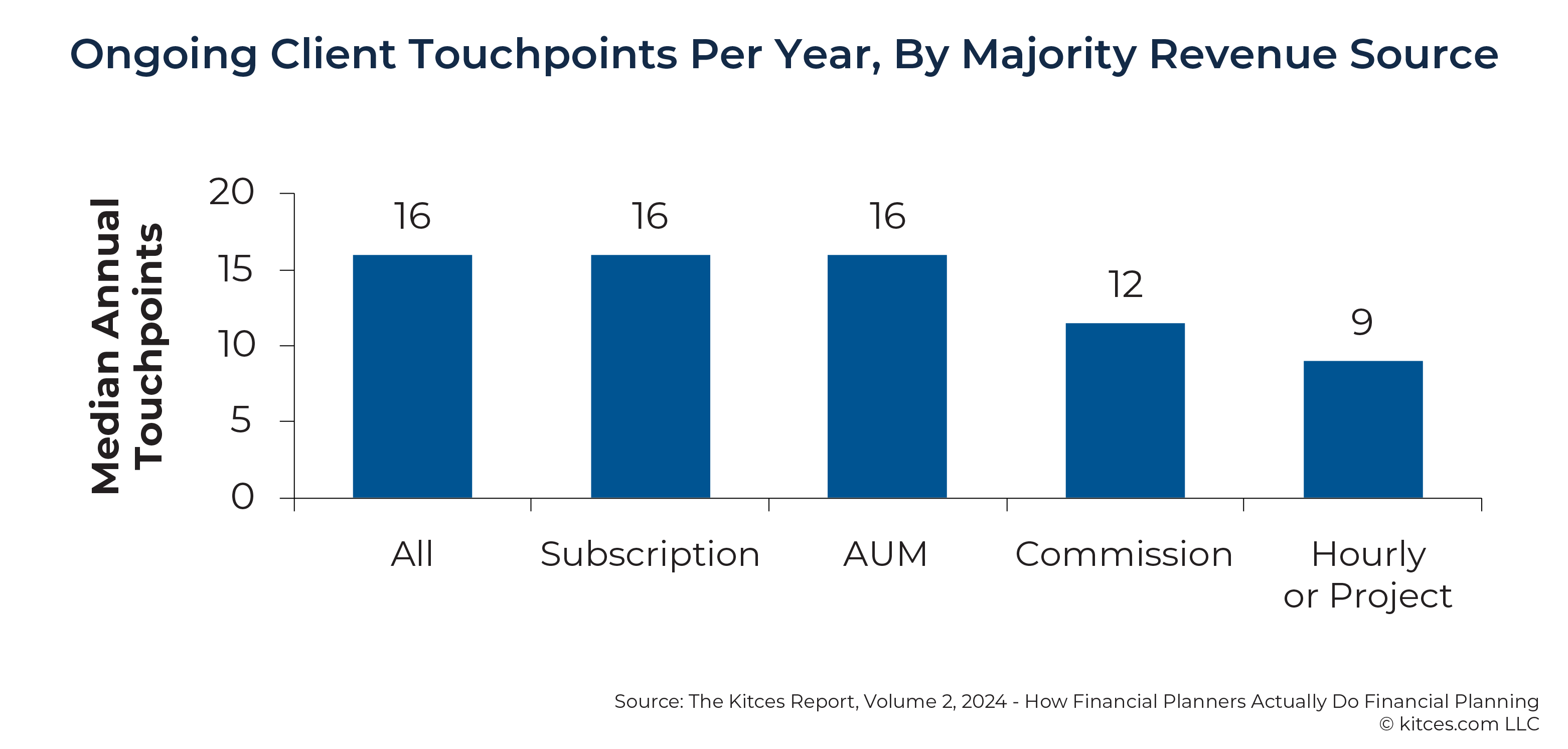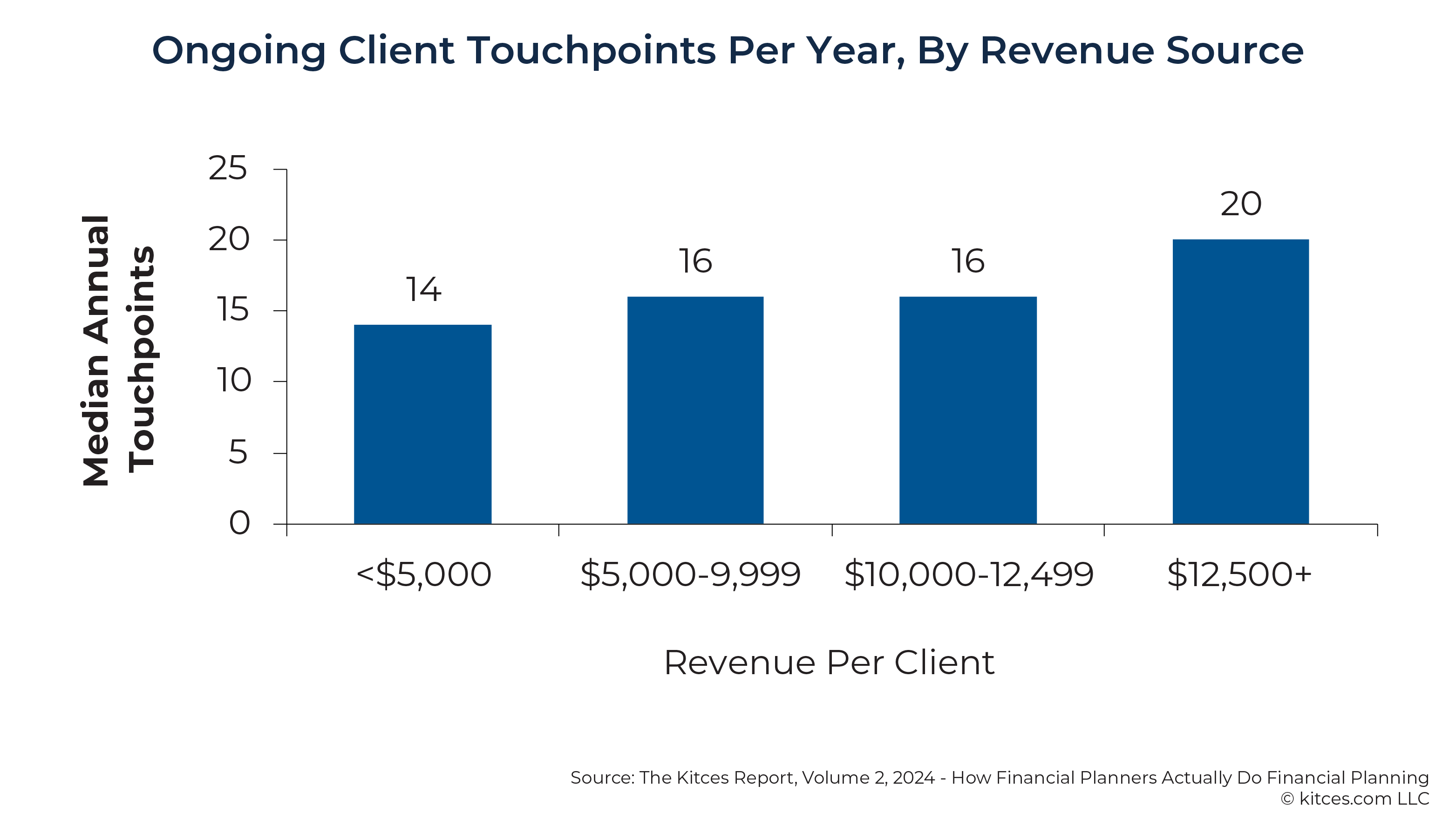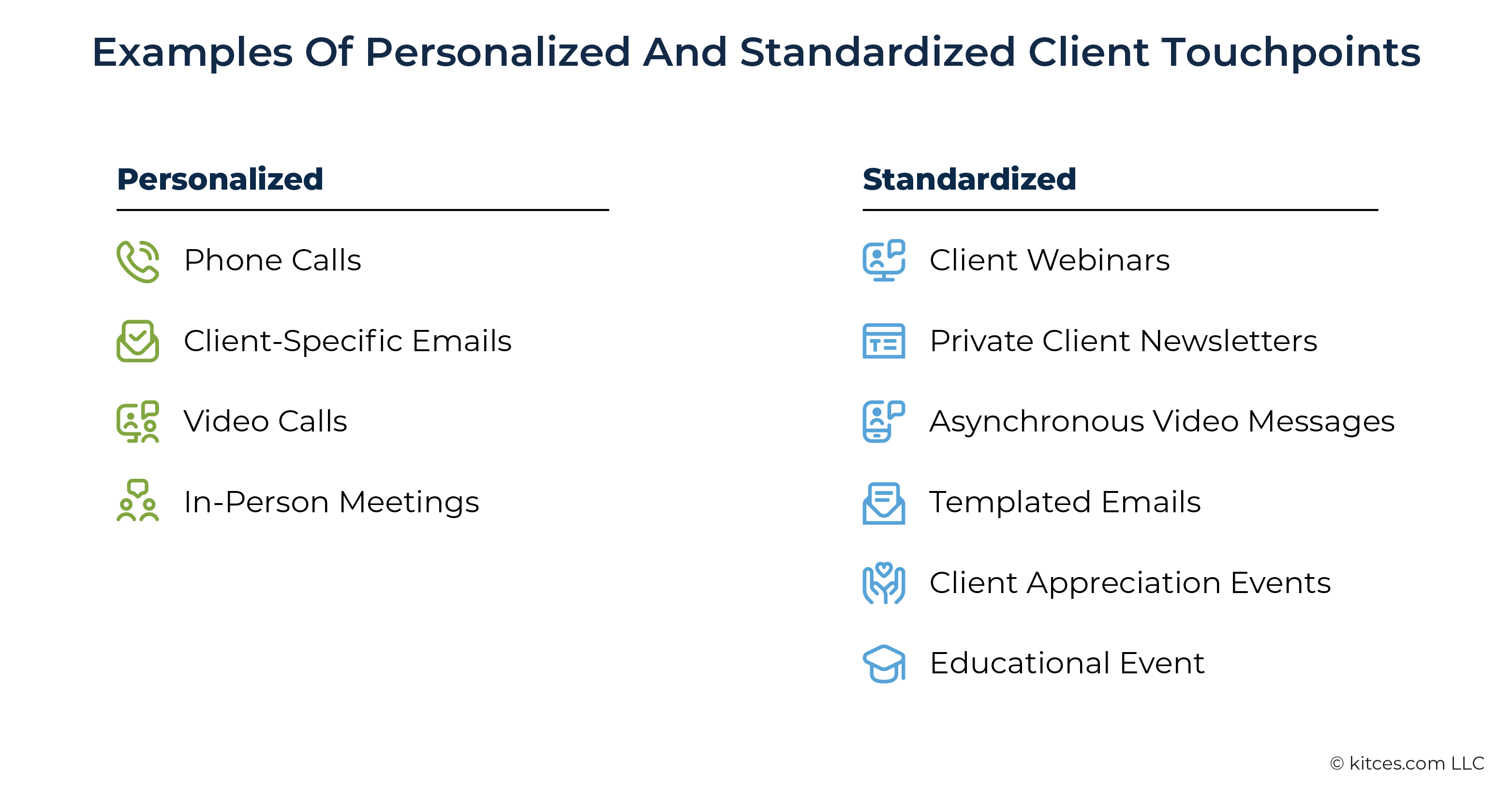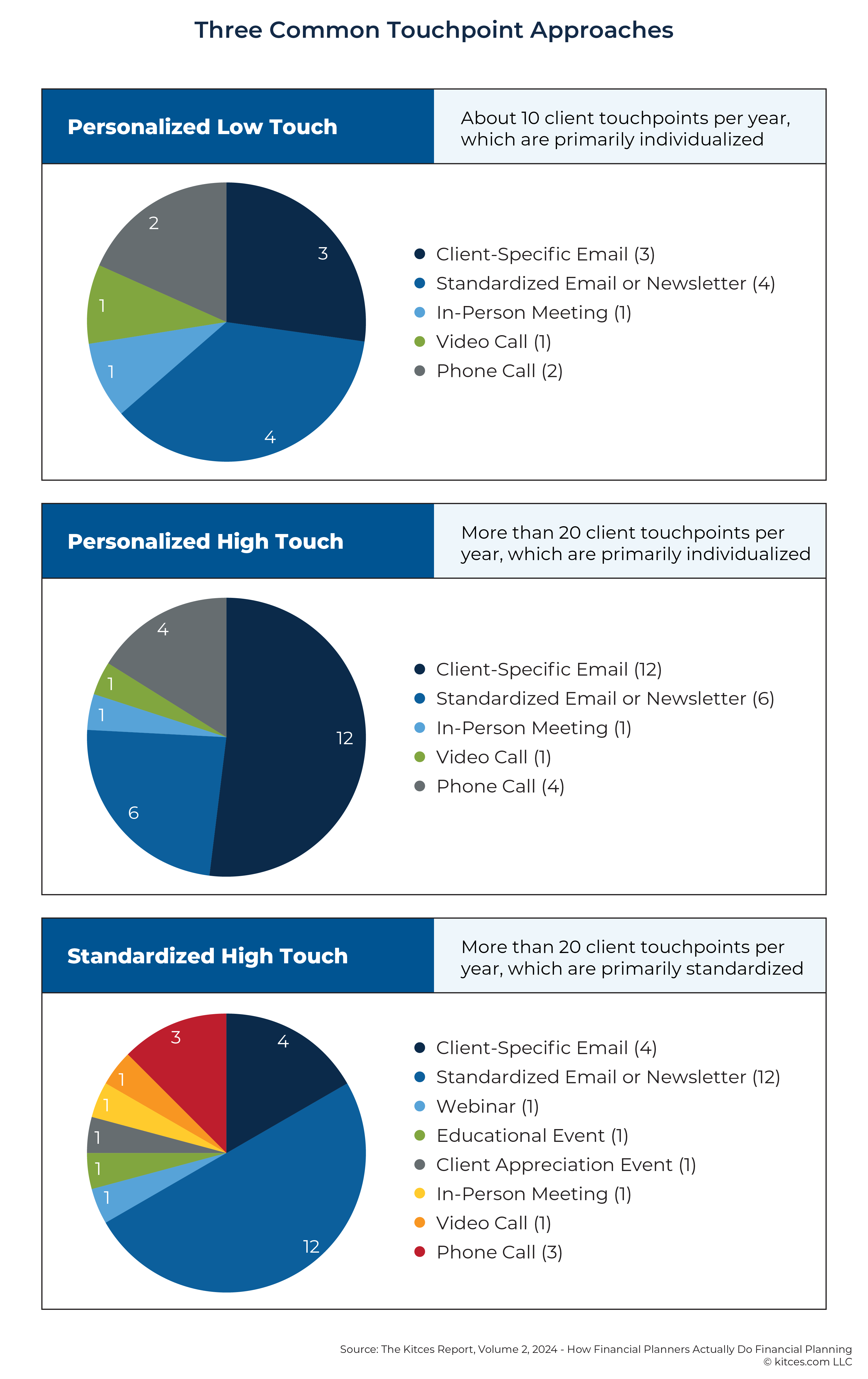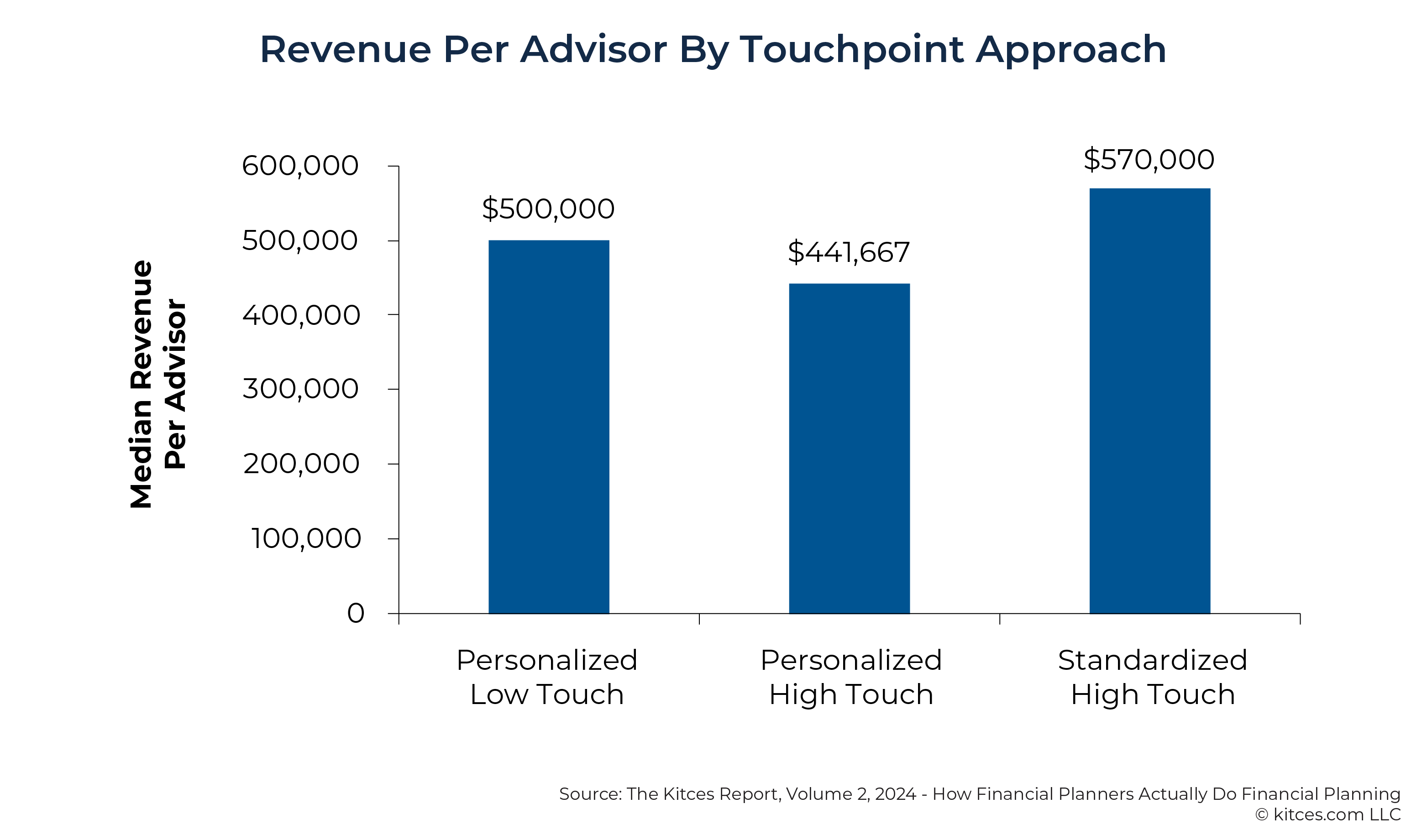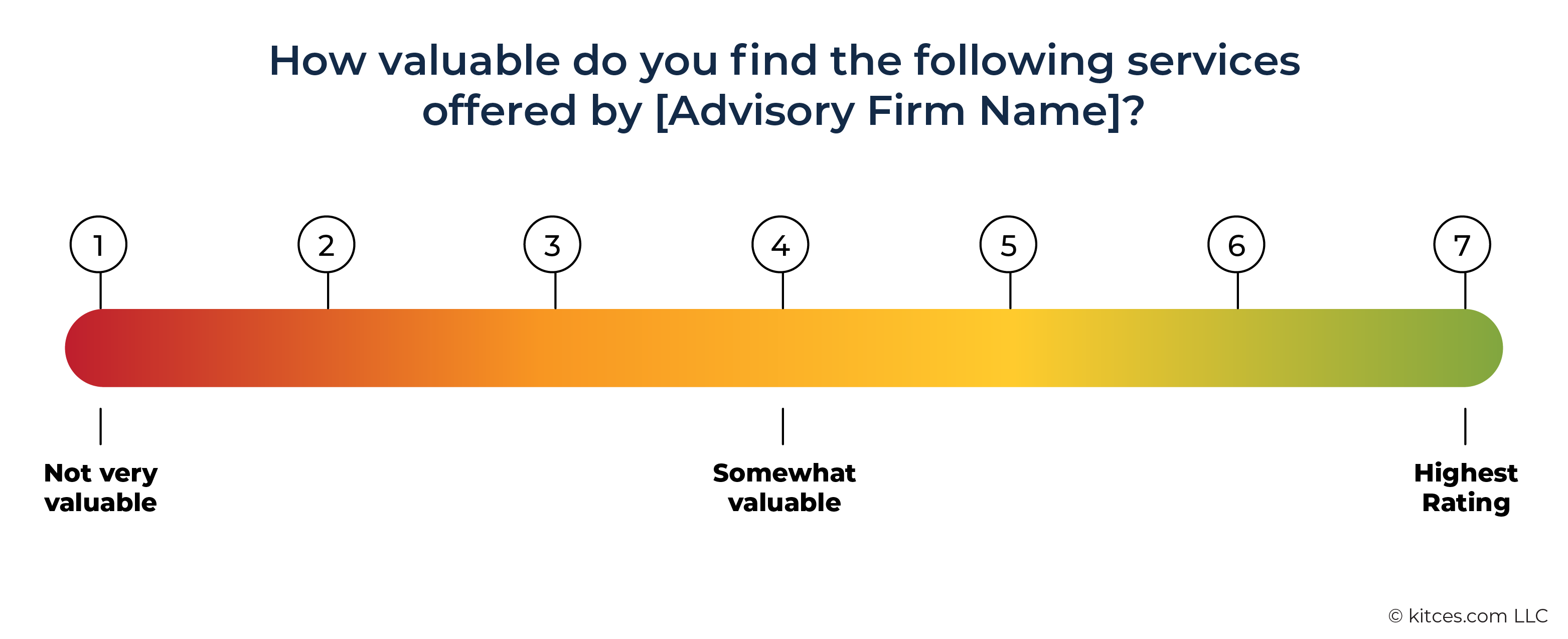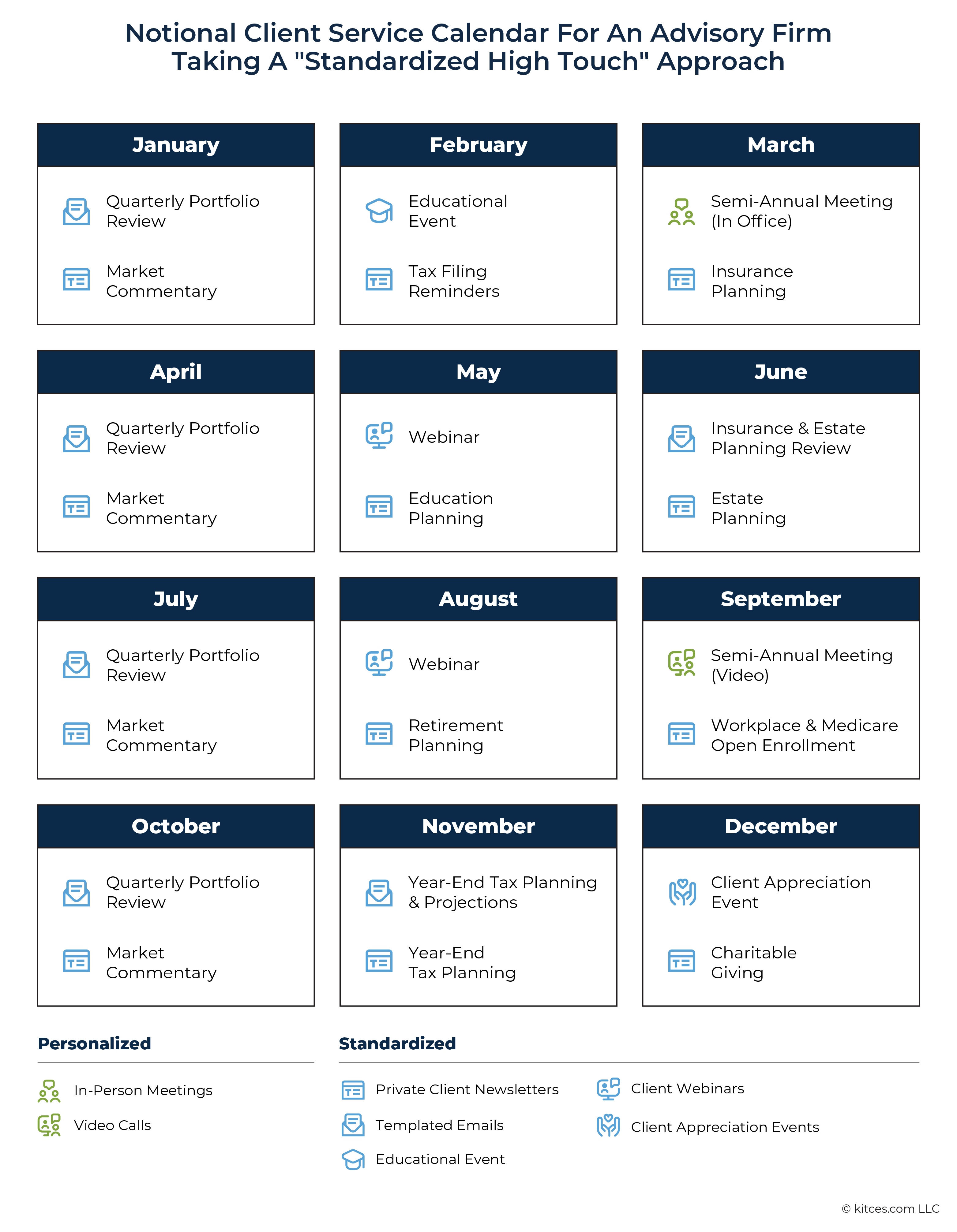Executive Summary
For a financial advisor and their new client, the first year working together can be a particularly intense period, typically involving multiple in-person or virtual meetings. After this first year, though, the number of scheduled meetings typically declines, often including only one or two formal meetings per year to check on progress toward financial goals and answer questions.
Beyond these formal meetings, though, advisors still often seek to create additional client touchpoints – interactions that can be either personalized (like one-on-one phone calls) or standardized (like newsletters sent to all clients). These touchpoints convey the ongoing value the advisor offers between meetings, particularly when clients are paying fees on a quarterly or even monthly basis.
In examining how these client touchpoints affect advisor productivity, the 2024 Kitces Research on How Financial Planners Actually Do Financial Planning found a positive correlation between the number of touchpoints and average revenue per client. In the study, advisory teams with less than $5,000 in average revenue per client reported a median of 14 annual client touchpoints, and those with $12,500 or more in average revenue offered a median of 20 touchpoints. Which suggests that advisors may offer more touchpoints when clients are paying higher fees, and that those clients may also expect more frequent engagement.
The revenue-per-client data also suggests that advisors aiming to move 'upmarket' may benefit from offering more frequent touchpoints – especially since clients paying higher fees often expect more engagement. However, client touchpoints aren't just about quantity – the type of touchpoint being offered also matters. For example, while personalized client phone calls require significant advisor time, standardized formats like newsletters or webinars can offer value more efficiently – and not every touchpoint format needs to be individualized to be effective.
In its examination of client touchpoint strategies, the Kitces Research Study on Advisor Productivity suggests that advisory firms tend to cluster into three broad groups based on the frequency and type of touchpoints they deliver: 1) Personalized Low Touch (about 10 touchpoints, primarily individualized through phone calls or personal emails; 2) Personalized High Touch (more than 20 touchpoints primarily individualized), and 3) Standardized High Touch (more than 20 touchpoints, primarily delivered through standardized means like client newsletters or webinars). Notably, service teams using a Standardized High Touch approach tend to report higher revenue per advisor than those using either Personalized Low Touch or Personalized High Touch approaches. This appears to be due in part to the ability to offer a greater number of touchpoints (linked to higher revenue per client) using less advisor time, freeing up staff capacity for other responsibilities.
Firms considering a shift to a Standardized High Touch approach can start by evaluating which types of client communication truly benefit from a more personalized approach – and which could be standardized without sacrificing client engagement. For instance, an advisor might hold a webinar addressing common client questions rather than repeating the same answers across several phone calls. Or, asynchronous video communication could allow advisors to offer personal responses without the need to coordinate schedules with the client. Further, firms with a high-touch offering can organize their client touchpoints into a clear, digestible format (e.g., a client service calendar) to help clients understand the full scope of what's available and what to expect throughout the year.
Ultimately, the key point is that by offering additional standardized touchpoints – in the formats that their clients find most valuable – advisors can strengthen client engagement and satisfaction (potentially leading to better client retention figures and more client referrals) without overextending themselves!
For a financial advisor and their new client, the first year working together can be a particularly intense period, typically involving multiple in-person (or virtual) meetings. These early interactions focus on understanding the client's situation, analyzing their financial picture, and developing a recommended course of action. After this first year, though, the number of scheduled meetings typically declines, often including only one or two formal meetings per year to check on progress toward financial goals, answer questions, and (perhaps when the client's situation has become a bit 'stagnant'), help identify new aspirations that will allow them to flourish.
Beyond these formal meetings, advisors often seek to create additional client touchpoints – interactions that can be either personalized (like one-on-one phone calls) or standardized (like newsletters sent to all clients). These touchpoints offer ways to demonstrate ongoing value between meetings, particularly when clients are paying fees on a quarterly or even monthly basis.
Still, choosing the right number of touchpoints can be a challenge for advisors, as too many could strain an advisor's time and resources, while too few could leave clients wondering whether their advisor is truly looking out for their needs. Notably, data from the 2024 Kitces Research Study on Advisor Productivity indicates that both the number and type of touchpoints advisors use can meaningfully affect their overall productivity (measured in revenue per advisor).
The Frequency And Types Of Client Touchpoints Advisors Use
For advisors aiming to demonstrate ongoing value, offering regular client touchpoints throughout the year can be a way to help maintain engagement – and even make visible some of the 'invisible work' that happens between meetings, such as monitoring markets or reviewing client portfolios. Some advisors might also offer a higher number of (or more personalized) touchpoints as a way to differentiate their firm in the marketplace for advice.
The cadence and the level of personalization can change over time as well. For example, in the early years of their firm, an advisor might have enough time on their hands to offer a higher-touch experience for clients simply because they have fewer clients to serve. However, as the firm grows, maintaining the same level of service can become unsustainable, possibly requiring new staff (which could affect firm profitability unless fees are raised accordingly).
The Relationship Between Touchpoint Strategy And Firm Revenue Model
An advisor's decision about how many touchpoints to offer could depend on a variety of factors, including the types of clients they work with and the complexity of their financial situations. According to the 2024 Kitces Research on Advisor Productivity, one key factor of this equation is the how the firm generates most of its revenue.
Nerd Note:
The 2024 Kitces Research Study on Advisor Productivity received responses from 621 participants who met the stringent qualifications and completion requirements necessary for inclusion in the analysis. Given that the survey drew from Kitces.com readers – a segment that tends to be more advice- and planning-centric than the broader advisor population – the results may represent a more planning-forward subset of the profession.
Also, most survey questions were answered at the service team level rather than by individual advisors (although for solo advisors, the individual advisor represents the 'team'). For the purposes of this research, a 'service team' is defined as one or more individuals working within a financial advisory firm who collectively serve and deliver financial planning advice to a defined client base, reflecting the recognition that multiple roles are often accountable for building and sustaining client relationships as well as developing, delivering, and maintaining financial plans.
Notably, touchpoint frequency was found to vary by revenue model:
- Service teams that earn the majority of revenue from Assets Under Management (AUM) or subscription fees reported a median of 16 client touchpoints per year.
- Firms that brought in most of their revenue from commissions reported a median of 12 touchpoints.
- Those relying on hourly or project-based fees had a median of 9 touchpoints.
This trend could reflect that firms charging recurring fees (e.g., AUM or subscription fees) offer more touchpoints to demonstrate the ongoing value they provide – to both clients and regulators. And that the work they put into them throughout the year is one way to justify their fees. Meanwhile, clients of hourly or project-based firms might limit the number of touchpoints with their advisor to control their costs.
Kitces Research also found a positive correlation between the number of client touchpoints and average revenue per client. Advisory teams with less than $5,000 in average revenue per client reported a median of 14 annual client touchpoints, while those with $12,500 or more in average revenue offered a median of 20 touchpoints. And teams between $5,000 and $12,500 had a median of 16 touchpoints. This trend suggests that advisors may offer more touchpoints when clients are paying higher fees, or that those clients may expect more frequent engagement – perhaps due to more complex needs or expectations tied to fee levels.
The revenue-per-client data may also suggest that advisors aiming to move 'upmarket' and serve clients willing to pay higher fees may benefit from increasing the number of touchpoints they offer – especially since higher-paying clients may expect more frequent engagement. However, client touchpoints aren't just about quantity, they're also about the type of touchpoint being offered. A personalized client phone call, for instance, requires far more advisor time than a standardized newsletter sent to all clients – and not every touchpoint format delivers the same return on that time investment.
Boosting The ROI From Client Touchpoints Through A "Standardized, High-Touch" Approach
Advisors quickly discover that not all touchpoints are created equal in terms of the time investment required. For instance, an advisor might offer clients two personalized 30-minute phone calls per year between regularly scheduled semi-annual meetings. Given the need to prepare for and record the details of the call, each 30-minute call could be expected to take a full hour. While this approach might sound reasonable in the context of one client, an advisor with a base of 80 clients might find themselves obligated to spend a total of 160 hours on this 'personalized' touchpoint.
By contrast, a quarterly, one-hour webinar can reach an advisor's full client base all at once. It might cover recent market developments, changes to tax rules, or other topics relevant to the group, allowing clients to ask questions and engage with the advisor. These 'standardized' touchpoints can scale more efficiently than one-on-one engagements, as the time the advisor spends on the event will depend only on how long it takes to prepare – not on the number of clients they need to reach.
Which raises a key question: While 'standardized' client touchpoints (e.g., standardized emails, newsletters, webinars, educational events, or appreciation events) can save time compared to more personalized forms of outreach (e.g., in-person meetings, client phone calls, or client-specific emails), does the time savings – which can be invested into other client service activities, business development tasks, or other opportunities – actually outweigh the possibility that clients will respond better to personalized touchpoints?
Three Different Touchpoint Strategies Advisors Are Using
In its examination of client touchpoint strategies, the Kitces Research Study on Advisor Productivity suggests that advisory firms tend to cluster into three broad buckets based on the number and type of touchpoints they deliver:
- Personalized Low Touch. Teams offer about 10 client touchpoints per year that are primarily individualized (e.g., client phone calls or personal emails).
- Personalized High Touch. Teams offer more than 20 client touchpoints per year that are primarily individualized.
- Standardized High Touch. Teams also offer more than 20 client touchpoints per year, but touchpoints are primarily standardized (e.g., client newsletters or webinars).
Notably, all three approaches included one annual in-person meeting and one annual video call.
Among these touchpoint approaches, the Personalized Low Touch model is the most common – used about three times more often than the other two combined. Firms in this category typically offer their clients approximately two phone calls, three client-specific emails, and four standardized emails or newsletters during the year.
Advisory teams using the Personalized High Touch model increase the number of touchpoints by adding two additional phone calls and standardized emails or newsletters (compared to the Personalized Low Touch approach) but stand out most significantly by offering a total of 12 individualized client emails (representing approximately monthly check-ins with clients).
Finally, advisory teams using the Standardized High Touch model offer about 12 monthly standardized emails or newsletters while also offering slightly more phone calls and client-specific emails than the Personalized Low Touch approach. A key distinction for this model is that firms in this group, on average, offer one client webinar, one educational event, and one client appreciation event each year, providing multiple ways to engage clients in a one-to-many format.
Advisor Revenue Implications Of Different Client Touchpoint Approaches
Given that advisors receiving the highest average per-client revenue typically offer more client touchpoints than other advisors – including more personalized interactions such as phone calls and individualized emails – the Personalized High Touch approach might initially seem like the most effective of the three models. However, this approach can come at a steep time cost, particularly as the level of personalization and number of touchpoints increase.
According to our Kitces Research data, advisory teams taking a Standardized High Touch approach reported the highest median revenue per advisor ($570,000), compared to $500,000 for the Personalized Low Touch approach and $441,667 for Personalized High Touch. These figures suggest that the return on offering more touchpoints depends, in part, on the ability to deliver them effectively. Because if touchpoints are too personal, the time commitment can take too much away from an advisor's ability to work on other important tasks. That said, firms that prefer a Personalized High Touch approach might still find it sustainable, provided that their current fees reflect the amount of work required to support that level of service.
However, transitioning to a more Standardized High Touch approach can come with several challenges. Firms that are concerned about the time demands of personalized touchpoints and hesitant to raise fees might consider shifting certain touchpoints to a more standardized format. For example, instead of emailing individual responses to common questions, an advisor might instead create a standard email newsletter covering frequently asked questions. Still, such a change could raise concerns that reducing depersonalization might reduce client engagement and, ultimately, retention – particularly among longtime clients who have been conditioned to the pace and personalization of more tailored touchpoints.
In these cases, taking a data-informed approach can help. By evaluating the types of client communication that would truly benefit from a more personalized approach – and which could be standardized without sacrificing client engagement – firms can craft a client touchpoint program that offers a high-touch experience without overextending the team's time and capacity.
How Advisors Can Identify The Right Balance Of Client Touchpoints For Their Practice
While our Kitces Research provides aggregated data from surveyed advisory teams, each financial planning practice is unique in terms of its value proposition and the preferences of its client base. With this in mind, even though taking a Standardized High Touch approach might offer greater revenue potential on average, the ideal mix of touchpoints chosen – and their frequency – will naturally vary from firm to firm.
Conducting A Client Engagement Survey To Identify Touchpoint Preferences
Advisors might be tempted to assume that clients prefer more time-intensive, personalized touchpoints, such as in-person meetings over phone calls, and phone calls over emails. However, this isn't always the case. In reality, some clients may favor more flexible or time-saving options. For instance, a client who has to travel 30 minutes each way for a one-hour meeting – and possibly take time off work – might prefer virtual meetings, phone calls, or perhaps even an asynchronous meeting, which could ultimately save time for both the advisor and their client.
One way to gauge how much clients value certain touchpoints is to conduct a client engagement survey, which allows clients to rate how much they value specific offerings. These surveys can help advisors identify what to improve, what to reduce, and what to continue offering – both in terms of format and frequency). For instance, an advisor might ask clients "How valuable do you find X service offered by our firm?" on a scale of 1–7. This can capture meaningful feedback from clients without overwhelming them. Including space for open-ended feedback allows clients to expand on why they selected a particular rating or make other suggestions.
For firms considering a more high-touch offering, feedback from these surveys can also help identify potential future services are most likely to resonate, increasing the chances that any additions will be relevant to and appreciated by clients.
Converting Personalized Client Touchpoints Into Standardized Touchpoints
With the results of a client engagement survey or similar exercise in hand, advisors can then begin refining their client touchpoint strategy – starting with opportunities to convert more personalized touchpoints into more standardized, scalable options. This allows advisors to offer their expertise to clients in a more efficient manner while still maintaining a sense of connection.
For example, during annual or semi-annual meetings, advisors may notice many clients asking similar questions (e.g., about ). Rather than communicating with clients individually, the advisor could address their concerns through a more standardized, one-to-many approach, such as a webinar, allowing time for Q&A (and perhaps giving clients the option to submit questions anonymously). And even if some clients email or call the advisor with follow-up questions after the webinar, this one-to-many approach can still save significant time compared to individually emailing all clients on the topic at hand.
The time savings from converting personalized touchpoints into standardized ones can also allow advisors to increase the number of touchpoints offered throughout the year. An advisor might explore standardized touchpoints that still emulate a one-on-one feel. For example, market commentaries can be sent through monthly private client newsletters, which (despite being sent to the advisor's full client base) may still feel intimate, reaching clients directly and inviting direct replies to the advisor, rather than being posted publicly on a blog.
Another way for advisors to offer a standardized touchpoint with a personal touch is to record short-form video messages (using a tool such as Loom), which allow clients to access the video at their convenience (saving both the client and the advisor the time it takes to schedule a synchronous meeting or call). This format lets the client see and hear their advisor, which can be a reassuring way to address client concerns during times of market turbulence.
For more individualized topics that might not be appropriate for a one-to-many medium, asynchronous videos can be a flexible way to address client-specific questions, providing a personal experience in an efficient manner without the time demands of a synchronous meeting.
Additionally, advisors can save time by creating email templates for common client milestones (e.g., reaching Medicare eligibility or beginning Required Minimum Distributions) or frequently asked questions. These templates can be personalized as needed but require far less time than composing new individualized messages from scratch, while still giving the impression of direct, thoughtful communication.
Communicating Touchpoint Offerings Using A Client Service Calendar
For firms with a high-touch service offering, organizing client touchpoints into a clear, easily digestible format can help clients understand the full scope of what's available to them and set expectations for what they'll experience throughout the year.
One way to do this is through a client service calendar, which can outline touchpoints and services across the calendar year. Not only does this give clients a sense of the actual work involved in financial planning outside of meetings, but it also helps them understand when specific services occur. Client service calendars can also help manage client expectations, allow advisors to adhere to their preferred service cadence (recognizing that some client issues will likely need to be handled on an ad hoc basis), and allow firm staff to focus on similar tasks at one time – freeing up capacity to deliver more consistent communication.
Furthermore, using client service calendars to outline the actual scope of work the advisor performs for clients can be helpful from a regulatory perspective. When advisors are asked to justify their fees, a well-structured service calendar can show the specific services clients receive and when they're delivered.
By gathering feedback from clients on which touchpoints they value most, identifying opportunities to standardize certain touchpoints, and communicating the scope and cadence of touchpoints being offered, advisors can offer a higher-touch level of service without a significant additional time commitment – which, in turn, can boost client engagement.
Ultimately, the key point is that client touchpoints offer advisors the opportunity to engage with their clients throughout the year, demonstrate the ongoing value they provide, and promote client satisfaction – potentially leading to better client retention figures and, possibly, more client referrals.
Further, while our Kitces Research data indicate that advisors working with higher-fee clients tend to offer relatively more touchpoints, they don't always need to be time-intensive or one-on-one. Rather, by offering additional standardized touchpoints – in the formats that their clients find most valuable – advisors can strengthen client engagement and satisfaction without overextending themselves!


